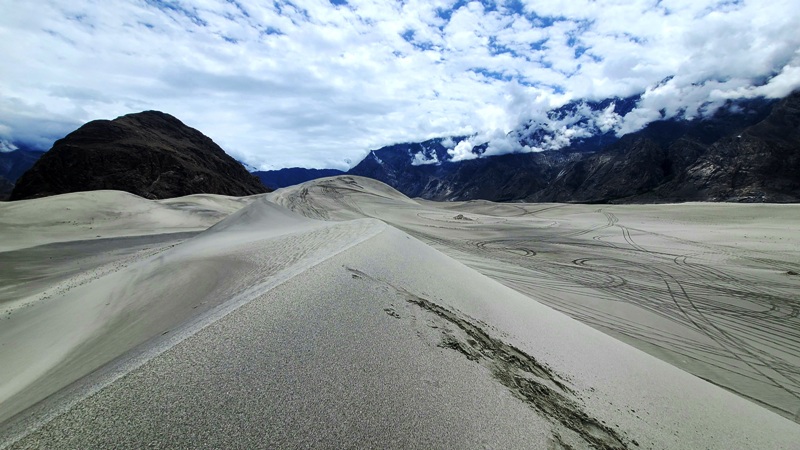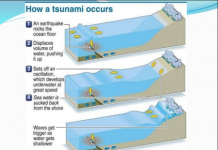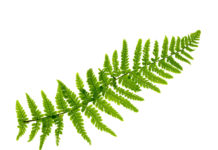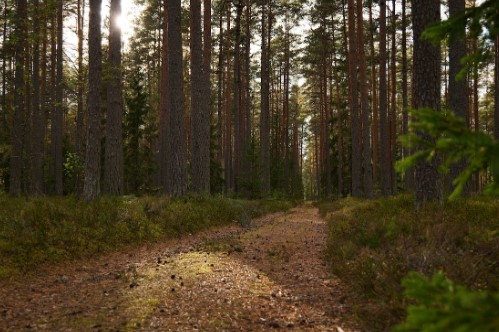How do Sand Dunes Build Up? A clump of rotting seaweed can start the whole process of dune buildings as sand forms around them. Plants take root and Marram dunes build up inland. Several gently sloping sandy shores are backed by sand dunes.
As the tide ebbs more and more sand is dried out by the sun and wind. Whenever the on-shore wind blows faster than 10 mph and is driven inland. Usually, it accumulates in dunes that run at right angles to the direction of the prevailing wind.

Fore-Dunes
The landward movement of sand is obstructed by the seaweed and refuse that accumulates along the high tide line. A small fore-dune begins to build up. The humus derived from the rotting seaweed is just enough to allow a few flowering plants to survive.
Sea rockets, prickly saltwort, sea beet, and in particular the two kinds of grass sea couch grass and lyme grass, all have creeping root systems that enable them to hand on during onshore gales. Even so, the fiercest of these gales often entirely obliterates the beginnings of the dunes.
Nevertheless, the time comes when the weather is calm over a long enough period to allow sufficient sand and humus to build up to give the main colonizing plant the depth of sand it needs for survival This plant is the marram grass. The increasing depth of sand eventually smothers the original colonists. As the main dune extends towards the sea, another strandline of drift builds up and a new fore-dune develops.
Marram Dunes
The root system of Marram progressively penetrates many feet deep while its stiff leaves more and more effectively obstruct the landward blowing sand. More leaves appear as the original plant sends out lateral roots; when a shoot is buried by sand it produces a bud that pushes up another vertical shoot. Marram can spread up to 9 am (30ft) sideways and 1m (3ft) vertically in one year. In this way, the dunes stabilize, rapidly increasing in height and width.
To begin with, the bare sand between the Marram tufts is a habitat of such extreme temperature and moisture ranges that no secondary plant colonizer can grow until enough humus from dead bits of Marram windborne plant refuse has accumulated, and a season of wet weather has enabled chance wind-borne seeds to germinate.
At this stage, the original fore-dune colonists reappear, along with sand sedge which binds the surface with long shallow runners, and the tight rosettes of Portland and sea spurge. When these plants die they humus to the sand which helps to contain moisture and provides nutrients for another generation of more tightly packed plants. The establishment of the thick dune vegetation (turf) is underway.
Adapting to Extremes
Sand Dunes plants have several features that allow them to survive the gale force winds the drying heat, the lack of moisture, and the wind-borne salt. Several have deep and extensive root systems to reach the water underground and anchor them securely. The scarlet pimpernel, for example, which also grows inland on non-sandy soil, develops much more extensive roots than its inland counterpart and grows almost horizontally to minimize the buffeting from the wind.
The rosette plants too are protected from the wind by hugging the ground closely. Sea-holly and sea bindweed have stiff varnished leaves which help to reduce water loss and give protection against abrasion by blown sand. The hairiness, even downiness, of many other plants such as the common stork’s-bill traps dew on their stalks and leaves. Winter annuals such as chickweeds and early forget–me-nots, thicken the turf. Their seeds germinate in autumn and survive the wet winter as seedlings, to flower and set seed again before the drought and heat of summer threaten survival.
At this stage of the vegetation, rabbits begin to browse the turf their droppings add to the supply of plant nutrients. By now the Marram has almost completely disappeared because it can survive only where bare new sand is plentiful. Mosses and lichens eventually cover these landward dunes which look more grey than yellow due to the amount of grey dog lichen growing on them.
Where Sand Dunes Meet Land
The type of vegetation in the final stages of the Sand Dunes depends largely on the quality of the sand. Where the sand consists mainly of mineral grains such as quartz (and not lime-rich shells) the humus remains too acidic to support any but a limited flora. In this case, heather or heath (and sometimes both) dominate the mature Sand Dunes and may even grow so far towards the sea that they mingle with the last surviving Marram.
Where the Sand Dunes contain a lot of finely ground shells the lime-rich pieces neutralize the dominant acidity of coastlines, providing the right conditions for thick scrub to dominate the dunes. Sea-buckthorn is very prominent in parts of north Norfolk, Kent, Somerset, and Glamorgan. Once the buck-thorn is established elder, blackthorn, and privet begin to be common
Dune Slacks
The bottom of the hollows between dunes is often wet and small pools of water stand in them. The flora of these slacks contains a group of plants not found together anywhere else. The creeping willow may make a hummocky carpet.
Marsh helleborine, wintergreen, bog pimpernel, and several species of fen and marsh orchid may be found growing side by side. The natterjack toad still survives in some of these slacks. When disturbed it has the distinction of being able to defend itself with a secretion from its skin “smelling” like burnt gunpowder, sulfur, and boiled Indian rubber a defense not to be sneezed at.
Hardy Survivors
A number of small creatures can survive among the Marram tufts. The temperature inside each tussock is cooler than on the surrounding sand and the air is slightly humid. Some species of spiders cling to the stems while others burrow into the sand below. They feed on flies that breed in the rotting vegetation of the strandline and are blown into the dunes. The spiders in turn form the food of the rare and beautiful sand lizard.
The camouflage colors of pale ochres, sandy greys, and reddish browns of the few dune moths make them hard to spot. Only a minimal supply of nectar is available for the adults. The shore wainscot is confined to elusively on Marram, while the sand dart feeds on sea holly and sea rocket. The long-legged and long-bodied sand wasps are comparatively conspicuous, occurring mostly along the southern coastline.
Birds and Mammals
While numbers of spiders and insects manage to survive the hardships of living in the dunes the poor plant cover restricts larger animals to a few kinds. Birds are probably the most visible of these. Terns, ringed plovers, and oystercatchers all nest along the shingle and at the high tide mark. Black-headed gulls build their nests in colonies in the dune vegetation and shelduck use rabbit burrows.
Skylarks and meadow pipits lay their eggs on the ground in mature dunes, where occasionally the short-eared owl nests too. Rabbits are the most common mammals; they tunnel burrows in the sand of the mature dunes and eat the well-established vegetation. Foxes sometimes prey on the rabbits, even using their abandoned burrows for dens. Hedgehogs, stoats, and weasels feed on small birds, “birds” eggs, and young rabbits.
Blow-outs
No matter what its plant composition the turf of Sand Dunes is thin and fragile. The passage of too many human feet can break up the vegetation as they pass from the car park to shore. Given half a chance the wind will exploit any break. In no time a small hole is a large blow-out. Great widths of the dune become unstable, sand drives inland, and the whole process of stabilizing has to start again.
How do Sand Dunes Build up?
Grey Dunes
Rabbit droppings fertilize the ground small plants invade, ousting the marram. Grey lichens give these stable dunes their color.
Marram Dunes
Marram grass spreads quickly blocking the blowing sand more efficiently. Buried Marram can push up through the sand. Only a few plant species can survive the wind-blown conditions of foredunes. As Marram takes root the dunes form large obstacles for the wind.
Fore-dunes
Seaweed and drift block the blowing sand and small fore-dunes build up. Rotting seaweed allows a few species of plants to take root.







